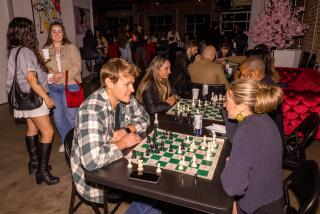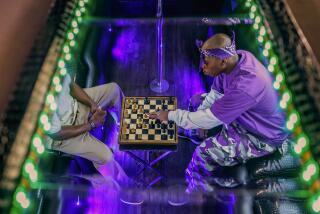Kramnik Surpasses Kasparov, Again
- Share via
May 4, 2001
Position #5636: Black to play and win. From the game Svidler--Korchnoi, Zurich 2001.
Solution to Position #5635: White wins a piece with 1 d5! cxd5 2 Nd4 Qe5 3 Nxf5 Bxe3 4 Nxe3, as 4 . . . d4 allows 5 Bxb7. If 1 . . . Qe4, then 2 Nh4 Qb4+ 3 c3 Qxb2 4 Bxh6 wins.
INTERNATIONAL NEWS
World champion Vladimir Kramnik defeated his predecessor, Garry Kasparov, to win a tournament of 25-minute chess last weekend in Zurich, Switzerland. The 12-player event celebrated the 70th birthday of Swiss grandmaster Viktor Korchnoi, who regularly trounces grandmasters a third of his age.
Saturday’s preliminary rounds eliminated four of the outclassed Swiss players. Kramnik topped his section with 3 1/2-1 1/2, a half-point ahead of semiretired former champion Boris Spassky. Kasparov dominated his section at 4 1/2- 1/2. On Sunday, the remaining eight grandmasters contested two-game mini-matches. Kramnik notched 1 1/2- 1/2 victories over Wolfgang Unzicker of Germany and Jeroen Piket, while Kasparov defeated Korchnoi and Nigel Short of England by the same score.
Kramnik won the final match with apparent ease. For the sixth time, he relied on the Berlin defense to the Ruy Lopez as Black, and for the sixth time, Kasparov had to concede a draw. As White in the second game, Kramnik enlivened a quiet position with a pawn sacrifice and later found a long combination to reach a winning endgame.
LOCAL NEWS
SuperNationals II, the largest American tournament ever, attracted 4,605 players to Kansas City last weekend. The tournament featured 13 sections for students in grades K-12.
Alen Melikadamian of Glendale tied for first place in the grades K-8 category with Keaton Kiewra of Nebraska and Daniel Leung of Illinois. Each scored 6 1/2- 1/2. Two other local stalwarts, Harut Keshishian and Vanessa West, tied for 12th place at 5 1/2-1 1/2.
Southern California High School champion Minas Nordanyan tied for fourth place with a 6-1 score in the K-12 section and led his team, Monroe H.S. of North Hills, to 12th place in the team competition. The field included six masters. Nordanyan lost only to Hikaru Nakamura, who shared first place at 6 1/2- 1/2 with fellow New York masters Samson Benen and Noah Siegel.
Other notable performances: Angel Garcia De Alba, tied for fourth at 6-1 in K-8 U750; his team, Steven M. White Middle School of Carson, fourth in K-8 U750; Aleksandr Kavutskiy, tied for third at 6-1 in K-5; Steven Zierk, 6-1, tied for third in K-3; and Sammy Kennedy and Tristan Sather, 5-2, tied for 10th place in the Kindergarten section.
Robert Hurdle scored 7-1 to win the Santa Monica Bay Chess Club championship. Ron Frasco finished second at 6 1/2-1 1/2, followed by top experts Ed Cohen and John Ward at 5 1/2-2 1/2. Roy Levin (best B) and George Bruce (best C or unrated) earned class prizes.
The club begins a quad tournament (three games against similarly-rated opponents) on May 7 in Joslyn Park, 633 Kensington Road in Santa Monica. For more information, call Pete Savino at (310) 827-2789.
The Exposition Park Chess Club, which meets Sunday afternoons in the public library, 3665 S. Vermont Ave. in Los Angeles, will conduct a free nonrated tournament on May 6. Register at the site at 1 p.m.
The May Octos will be held May 12 at The Chess Center, 2651 Irvine Ave. in Costa Mesa. Mike Carr runs these three-round, eight-player sections every two months. For details, call him at (949) 768-3538 or send a message to mrcarr@pacbell.net.
Edward Sanjenis swept the 25-player Spring Special at the Arcadia Chess Club with a perfect 5-0 score. Gordon Brooks (best A), Fred Brock (best B) and Richard Luchetta (best C-D-unrated) excelled in their rating groups.
The Arcadia Chess Club will host the five-round B. T. McGuire Memorial on Monday evenings, beginning May 7. The club meets at 6:30 p.m. Mondays in the Senior Citizens building, 405 S. Santa Anita Ave. in Arcadia. Call Fred Brock at (626) 331-1638 for information.
TODAY’S GAMES
GM Kramnik (Russia)--GM Kasparov (Russia) #2, Zurich 2001: 1 d4 Nf6 2 c4 e6 3 Nf3 d5 4 Nc3 dxc4 Inviting the complicated Vienna variation, 5 e4 Bb4 6 Bg5 c5. 5 e3 a6 6 Bxc4 b5 7 Bd3 c5 Reaching a position from the Queen’s Gambit Accepted. 8 a4 b4 9 Ne4 Nbd7 10 Nxf6+ Nxf6 11 0-0 Bb7 12 dxc5 Black has few worries after 12 Qe2 cxd4 13 Nxd4 Be7. Bxc5 13 Qe2 Qd5! Theory cites Flohr--Vidmar, Sliac 1932, which varied with 13 . . . Qe7 14 e4 h6. 14 Rd1 Qh5 15 h3 Not 15 e4? Ng4. Rd8! Preventing 16 e4 because of 16 . . . Nxe4 17 Bxe4 Rxd1+. Black does not quite equalize with 15 . . . Bxf3 16 Qxf3 or 15 . . . 0-0 16 e4 or 15 . . . Ne4 16 Qc2 Nf6 17 e4. 16 Nd4 Qd5 Also satisfactory is 16 . . . Qxe2 17 Bxe2 Bxd4 18 exd4 Nd5. 17 Nf3 Ke7?! Rejecting repetition by 17 . . . Qh5. 18 e4! A promising pawn sacrifice, justified by Black’s uncastled King. Nxe4 19 Be3 Bxe3 20 Qxe3 Qc5 21 Qe1 Nf6 Black must retreat, as 21 . . . f5? 22 Rac1 Qa5 allows 23 Rc4!, foreseeing the deadly finishes 23 . . . Qxa4? 24 Rc7+ Rd7 25 b3! and 23 . . . Nd6? 24 Nd4! Nxc4 25 Qxe6+ Kf8 26 Bxc4 Bd5 27 Qxf5+ Kg8 28 Nc6. 22 Rac1 Qb6 23 Ne5 Rd4?? The correct 23 . . . Nd5 keeps the outcome unclear. 24 Bxa6!! An astonishingly deep combination for a 25-minute game. The simpler 24 Nc4! Rxc4 (not 24 . . . Qc5 25 Ne3 Qg5 because 26 Rc7+ Rd7 27 Qxb4+ wins the Bishop) 25 Rxc4 a5 26 Qe5 should win, too. Rxd1 If 24 . . . Re4 25 Qd2 Rxe5 (nor will 25 . . . Bd5 26 Nc6+! Kf8 27 Bd3 Rh4 28 a5 save Black) 26 Bxb7 Rd8, not convincing is 27 Qf4?! Rc5, but White obtains a winning endgame by 27 Qxd8+ Qxd8 28 Rxd8 Kxd8 29 Rc4 Re1+ 30 Kh2 Re2 31 Rxb4 Rxf2 32 a5. 25 Rxd1 White plans to refute 25 . . . Qxa6 by 26 Qxb4+ Ke8 27 Rd6 Qa7 (or 27 . . . Nd5 28 Rxa6 Nxb4 29 Rb6) 28 Rb6 Bc8 29 Qc5! Qa8 30 Nc6 Nd5 31 Rb8 Qa6 32 Qd6. Bxa6?! Toughest is 25 . . . Rc8! 26 Bb5 Nd5. 26 Qxb4+ Qxb4 27 Nc6+ Kf8 28 Rd8+ Ne8 29 Nxb4 Be2 The pawns are unstoppable. For example, 29 . . . Bb7 30 a5 g6 loses to 31 Rb8 Bd5 32 Nxd5 exd5 33 a6 Kg7 34 a7 Nc7 35 b4 d4 36 b5 d3 37 Kf1 Na8 38 Ke1 Rf8 39 Kd2 f6 40 Kxd3 Kf7 41 Rxa8 Rxa8 42 b6. 30 f3 h5 No better is 30 . . . Ke7 31 Nc6+ Kf6 32 b4, and the pawns roll. 31 b3 Rh6 32 Kf2 Rg6 33 Kxe2 Rxg2+ 34 Kd3 Rg3 35 a5 Rxf3+ 36 Kc4, Black Resigns. After 36 . . . Rf1 or 36 . . . Rf5, simply 37 Nc6 prepares the advance of the a-pawn.
GM Kasparov (Russia)--GM Korchnoi (Switzerland), Zurich 2001: 1 e4 e6 2 d4 d5 3 Nc3 Nf6 4 Bg5 Be7 5 e5 Nfd7 6 h4 The Alekhine-Chatard Attack against the French Defense. Bxg5 7 hxg5 Qxg5 8 Qd3!? Rare. Usually White continues 8 Nh3 Qe7 9 Nf4. Nc6 Both 8 . . . h6 9 Nh3 Qe7 10 Nf4 and 8 . . . g6 9 Nf3 Qe7 10 Qe3 a6 11 0-0-0 c5 produce fresh positions. 9 Nf3 Qg6 10 Qxg6 fxg6 11 Nb5 Ke7 Avoiding 11 . . . Kd8? 12 Ng5. 12 Nxc7 Rb8 13 Nb5 Nb6 14 c3 White has the advantage in the center and on the h-file. Bd7 15 Bd3 Na5 16 b3 Bxb5 17 Bxb5 h6?! 18 Nh4! Rhc8 Expecting counterplay from 19 Kd2 g5 or 19 Nxg6+ Kf7 20 Nf4 Rxc3. 19 Rh3! g5 20 Ng6+ Kf7?? Black had to settle for 20 . . . Kd8 21 Rf3 a6, although 22 Rf8+ Kc7 23 Rf7+ Kd8 24 Bd3 Rxc3 25 Kd2 Rcc8 26 Rxg7 Nc6 27 Ke3 leaves White in command. 21 Rf3+! Kxg6 22 Bd3+ Kh5 23 Rh3+ Kg4 24 f3+ Kf4 25 Kf2 g4 26 g3+, Black Resigns.
More to Read
Go beyond the scoreboard
Get the latest on L.A.'s teams in the daily Sports Report newsletter.
You may occasionally receive promotional content from the Los Angeles Times.










